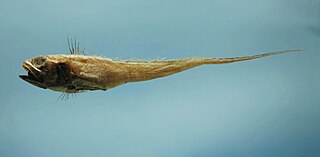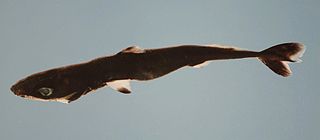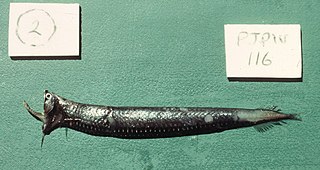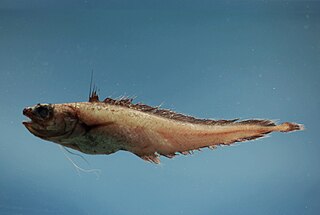
Stomiiformes is an order of deep-sea ray-finned fishes of very diverse morphology. It includes, for example, dragonfishes, lightfishes, loosejaws, marine hatchetfishes and viperfishes. The order contains 4 families with more than 50 genera and at least 410 species. As usual for deep-sea fishes, there are few common names for species of the order, but the Stomiiformes as a whole are often called dragonfishes and allies or simply stomiiforms.

Macrouridae is a family of deep sea fish, a diverse and ecologically important group, which are part of the order of cod-like fish, the Gadiformes. The species in the Macrouridae are characterised by their large heads which normally have a single barbel on the chin, projecting snouts, and slender bodies that taper to whip-like tails, without an obvious caudal fin but what there is of the caudal fin is often confluent with the posterior dorsal and anal fins. There are normally two dorsal fins, the anterior dorsal fin is quite high, the posterior quite low but is longer and takes up a greater proportion of the fish's of the back, species in the subfamily Macrouroidinae have a single dorsal fin. The long anal fin is almost as long as the second dorsal fin is nearly as long as the posterior dorsal, and sometimes it is longer. The pelvic fin is inserted in the vicinity of the thorax and normally has 5-17 fin rays but are absent in Macrouroides. The body is covered in small scales and if they have a photophore, it is usually on the midline of the abdomen just in front of the anus. The bioluminescence of these fish is produced by symbiotic bioluminescent bacteria. The structure of the skull has been used to show their placing in the Gadiformes, but they differ from the typical cods in that they possess one stout spine in the anterior dorsal fin.
Telescopefish are small, deep-sea aulopiform fish comprising the small family Giganturidae. The two known species are within the genus Gigantura. Though rarely captured, they are found in cold, deep tropical to subtropical waters worldwide.

Stomiidae is a family of deep-sea ray-finned fish, including the barbeled dragonfishes. They are quite small, usually around 15 cm, up to 26 cm. These fish are apex predators and have enormous jaws filled with fang-like teeth. They are also able to hinge the neurocranium and upper-jaw system, which leads to the opening of the jaw to more than 100 degrees. This ability allows them to consume extremely large prey, often 50% greater than their standard length.

Sloane's viperfish, Chauliodus sloani, is a predatory mesopelagic dragonfish found in waters across the world. The species was first described by German scientists Marcus Elieser Bloch and Johann Gottlob Schneider in their 1801 book Systema ichthyologiae: iconibus CX illustratum, volume 1. Female C. sloani reach maturity between 133 and 191 mm, while males likely reach maturity at slightly smaller body lengths. It has two rows of photophores along its ventral side. It is believed that C. sloani can adjust the intensity of bioluminescence of the ventral photophores to camouflage itself from predators that might see its shadow from below.

The whitefin dogfish is a species of deep-sea dogfish shark in the family Etmopteridae. It has only been found in the northwest Pacific Ocean off the southeastern coast of Japan, between the latitudes of 35 and 32°N. It inhabits continental slopes and seamounts at a depth of 320 to 1,100 m. Reproduction is ovoviviparous. It is of no interest to fisheries and almost nothing is known of its biology. The specific epithet ritteri is in honor of Dr. William Emerson Ritter of the University of California.

The spined pygmy shark is a species of squaliform shark in the family Dalatiidae found widely in all oceans. Growing no larger than roughly 28 cm (11 in), it is one of the smallest sharks alive, with this record beaten by the dwarf lanternshark. This shark has a slender, cigar-shaped body with a sizable conical snout, a long but low second dorsal fin, and an almost symmetrical caudal fin. Its sister species S. aliae and it are the only sharks with a spine on the first dorsal fin and not the second. Spined pygmy sharks are dark brown to black, with numerous bioluminescent organs called photophores on their ventral surface. The shark is believed to use these photophores to match ambient light conditions, which break up its silhouette and help the shark to avoid being seen by predators below.

Vinciguerria attenuata, commonly known as the slender lightfish, is a small species of ray-finned fish in the family Phosichthyidae, found in deep water in warmer parts of the Atlantic, the Indian and Pacific Oceans.
Eustomias schmidti, more commonly known as the scaleless dragonfish, is one of the many species included in the family of Stomiidae. Despite its small size, the scaleless dragonfish is a dangerous predator in the deep oceanic waters that uses its self-generated light to attract its prey.

Idiacanthus is a genus of barbeled dragonfishes, the larvae of which are noted for exhibiting the Stylophthalmine trait.

Stomias is a genus of barbeled dragonfishes. They live in the mesopelagic zone of all oceans and show diel vertical migration and sexual dimorphism (males are smaller, have larger eyes and larger postorbital photophores than females.

Sternoptyx diaphana, the diaphanous hatchetfish, is a species of deep sea ray-finned fish in the family Sternoptychidae. It is the type species of the genus Sternoptyx, and was first described by the French naturalist Johann Hermann in Der Naturforscher 1781.
Astronesthes richardsoni, or Richardson's snaggletooth, is a species of small, deep sea fish in the family Stomiidae. It occurs in the tropical western Atlantic Ocean, the Caribbean Sea and the Gulf of Mexico. First described by the Cuban zoologist Felipe Poey in 1852, it was named Chauliodus richardsoni in honour of the Scottish explorer and naturalist John Richardson. It was later transferred to the genus Astronesthes.

Astronesthes niger, commonly known as snaggletooth, is a species of small, deep sea fish in the family Stomiidae. It occurs in the tropical and subtropical Atlantic Ocean, the Caribbean Sea and the Gulf of Mexico, as well as the Indian Ocean and western Pacific Ocean, at depths to 1,000 m (3,300 ft).

Notoscopelus elongatus is a species of lanternfish in the family Myctophidae. It is endemic to the Mediterranean Sea where it is found in deep water habitats, rising to near the surface to feed at night and descending to great depths by day. It is a common species with no particular threats, and the International Union for Conservation of Nature has listed its conservation status as being of least concern.

The short beard codling is a species of marine bony fish in the family Moridae. Native to the western Atlantic Ocean, it is found on the continental slope at depths between 50 and 1,620 m.
Stomias affinis, also known as Gunther's boafish, is a deep-sea mesopelagic fish species in the family Stomiidae. They inhabit the open seas in the equatorial zones of the Atlantic, Indian and Pacific Oceans.
Leptostomias gladiator is a species of fish in the family Stomiidae. It is sometimes called the scaleless dragonfish, but that name is shared with many other species.

Stomias boa, also known as the boa dragonfish, scaly dragonfish, dragon-boa or boa scaly dragonfish, is a species of deep-sea fish in the family Stomiidae.
Stomias boa ferox is a subspecies of deep-sea fish in the family Stomiidae.














